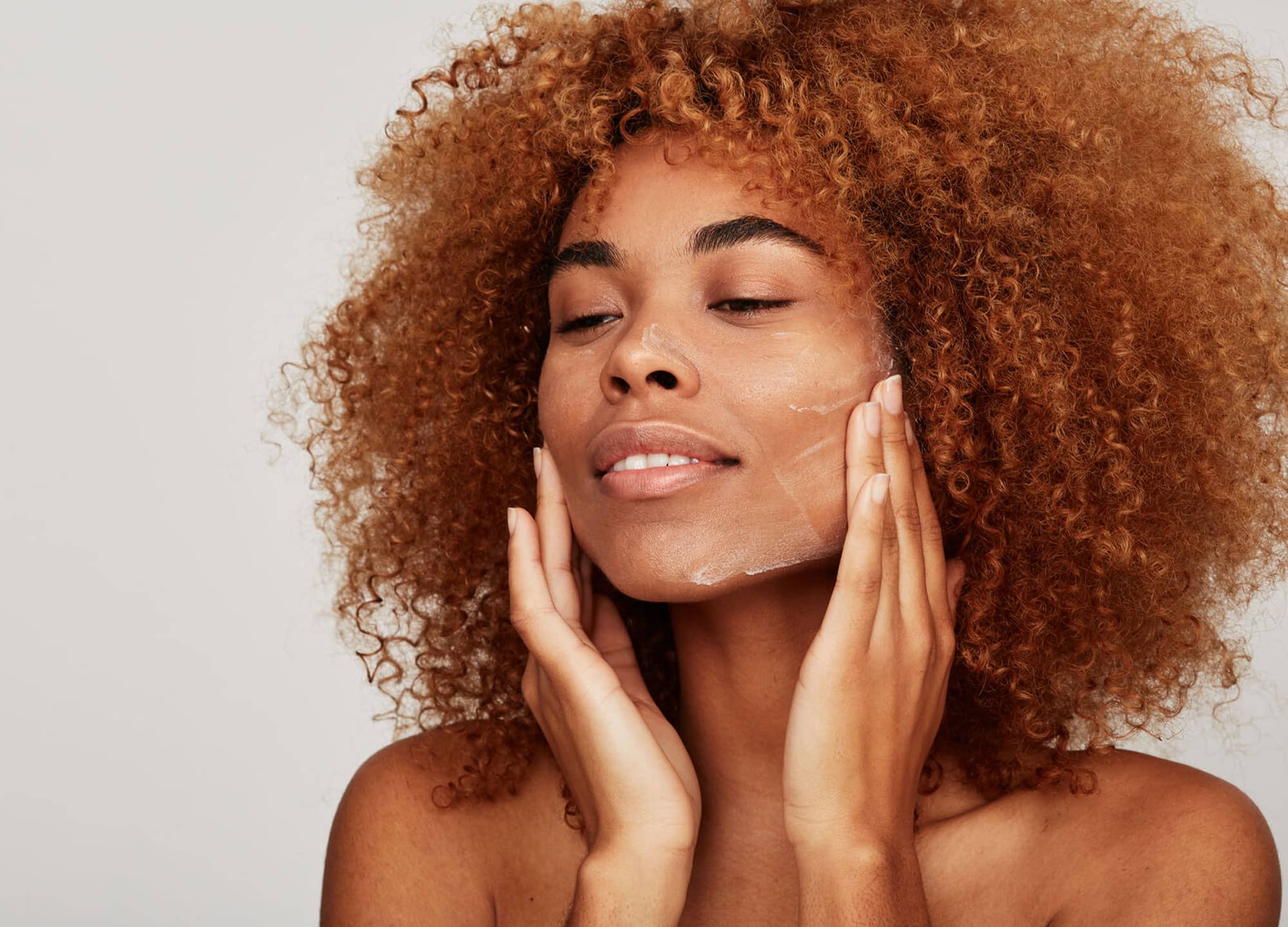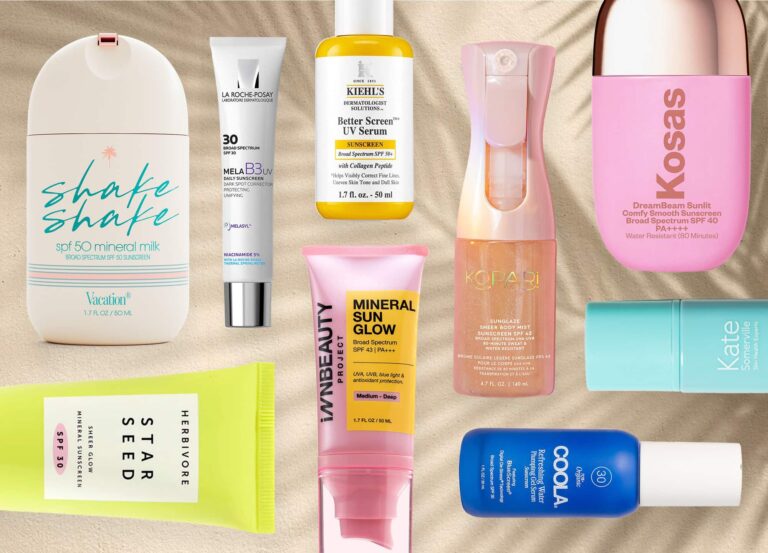Stats about how much skin humans shed regularly are arguably gross; we’ll spare you the gruesome details. But if you reframe the narrative just a tad, this shedding is actually extremely appealing: You get fresh, healthy, new skin cells on a routine basis, brightening skin tone, clearing breakouts, and resurfacing texture. Out with the old and in with the new!
Helping skin shed its dead cells and in turn encouraging healthy cell turnover is important to any skin-care routine. And there’s one group of common ingredients that are all-stars in this regard: exfoliating acids.
“Exfoliating acids are helpful in a variety of skin concerns,” says Dr. Amy Paul, a dermatologic surgeon in Grand Junction, Colorado. This includes acne, signs of sun damage (like sunspots), fine lines, and large pores. Overall, they can lead to skin feeling smoother and looking brighter, with improved uneven skin texture and tone. Whether you’re using acid exfoliants at home or scheduling in-office chemical peels, they could be the key to revealing your bright future.
How do exfoliating acids work?
“Exfoliation” may conjure up images of grainy scrubs and motorized brushes, but chemical exfoliation is a whole different game. Rather than manually scraping away dull, dead skin—which is how physical exfoliants like scrubs and brushes work—acid exfoliants make skin cells shed more effectively on their own, no abrasion required.
“Cell turnover is skin’s natural process of shedding your old, dead skin cells and making way for the newer cells underneath,” says Victoria Fu, a cosmetic chemist and one half of the duo behind the popular Instagram-account-turned-product-line Chemist Confessions. “As we age or when skin is stressed, this process slows down. Chemical exfoliants weaken the grip of these stubborn old cells and speed up the cell turnover process.”
There are tiny protein “glue spots,” called desmosomes, that bond skin cells together, says cosmetic chemist Kelly Dobos. “Acid exfoliants loosen these connections, allowing the dead skin cells to shed [and] revealing softer, younger-looking skin.”
Just because it’s fun to say, the word for this shedding process is desquamation.
AHA vs BHA vs PHA
Alpha hydroxy acid (AHA)
A whole bunch of acids fall under the alpha hydroxy acid category—namely, glycolic acid, lactic acid, citric acid, malic acid, tartaric acid and mandelic acid. They may be naturally derived (typically from fruit) or produced synthetically. You can find these various acids—on their own or in combination—across cleansers, toners, moisturizers, spot treatments, masks and peels, including in-office chemical peels performed by an aesthetician or dermatologist.
AHAs are water soluble, and therefore don’t penetrate the sebum-based buildup in pores. As a result, AHAs tend to be a better bet for treating dull skin, hyperpigmentation and dark spots, and fine lines and wrinkles because they work mainly on the surface of the skin.
When differentiating between these acids, size matters—molecule size, that is. Smaller molecules get into the skin more easily and work faster. Larger molecules, such as lactic acid, are gentler and take more time to work. Glycolic acid has the smallest molecules of the AHA family, allowing it to get deep into skin.
Beta hydroxy acid (BHA)
BHA is synonymous with salicylic acid in skin-care formulations. It’s oil-soluble, which means BHA exfoliants can get deeper into the pores to remove dead skin cells and excess sebum, making them suitable for oily skin and to help unclog blemishes, clogged pores, and blackheads.
The anti-inflammatory properties of salicylic acid (the same ingredient aspirin is derived from) can also make it a good choice for treating redness and rosacea.
Poly hydroxy acid (PHA)
There’s a third type of acid on the rise: polyhydroxy acids (PHA), which include gluconolactone and lactobionic acid. Their relatively large size make them good for sensitive skin, because they work exclusively on the skin’s surface without going too deep. Plus, gluconolactone even offers some antioxidant properties.
Choosing the right acid for skin
Choosing the best acid for your skin may take some experimenting. “The general rule of thumb is glycolic acid for normal and mature skin with stubborn pigmentation, lactic acid for sensitive or dry skin, and salicylic acid for oily and acne-prone skin,” says cosmetic chemist Gloria Lu, the other half of Chemist Confessions. “You should look for efficacy in two weeks to a month of consistent use. As a general guideline, an acid that delivers efficacy without excessive redness and irritation is considered a good fit.”
Many products combine AHAs with salicylic acid exfoliants, sometimes even a PHA too. “Combining some acids can enhance efficacy,” says Dobos. “But the drawback is that these combinations can be more irritating.”
Dobos recommends using “rinse-off cleansers that limit contact time with exfoliating acids and include hydrators.” She recommends the Glow Recipe Blueberry Bounce Gentle Cleanser ($34), which includes both glycolic acid and lactic acid.
What acids should you look for in an ingredients list?
Of course, you want to spot the acids by name before buying a product, but as active ingredients, their simple presence isn’t enough to indicate an effective formulation. What’s important is the concentration, aka the percentage, of said acid included in the product.
“Many products will call out the concentration,” says Dobos. “Products like moisturizers and cleansers typically contain less than 10% acid and are formulated in a pH range to limit irritation.” AHA and BHA exfoliants between pH 3 and 4 are considered safe and effective. Dobos also notes that acids may be serving other functions—like citric acid as a pH adjuster or salicylic acid as a preservative—and in those cases, the concentration won’t be disclosed.
If you want to reap the exfoliating rewards though, percentages matter. “With any skin care active, you need the right percentage to get benefits,” says Lu. “We prefer to reach for products that do disclose their percentages—that way, you know how your skin handles [that specific] amount of an ingredient. Knowledge is power!” Fu emphasizes the point further: “If you don’t know the percentage, it’s absolutely not worth your money at all.”
The percentage range for salicylic acid exfoliants is 0.5% to 2%, as allowed by the U.S. Food and Drug Administration (FDA) for sale in over-the-counter products. “Paula’s Choice Skin Perfecting 2% BHA Liquid Exfoliant [$30] is a cult-favorite toner that our followers love [for helping] to keep skin congestion-free,” say Fu and Lu. For acne spot treatment, Dobos recommends Peace Out Acne Healing Dots ($19), which are hydrocolloid bandages with 0.5% salicylic acid that can be applied to a pimple and left on overnight, for targeted treatment.
The concentration of alpha hydroxy acids need to be higher to work: 8–12%, says Fu. In the case that brands don’t disclose percentages (which happens a lot, unfortunately), make sure that the acids are high up on the ingredients list, since the ingredients are listed in order of their concentrations within the product. Skin care brands may use “peel” in the name of such products, but your skin shouldn’t actually peel. Instead, the products work slowly over time to slough off dead skin cells.
If you’d like to primarily treat hyperpigmentation, Dr. Paul recommends glycolic acid, mandelic acid and azelaic acid (a somewhat under-the-radar dicarboxylic acid)—but she warns to proceed with caution: “Always consult a dermatologist before attempting to lighten melasma, as many products make it worse. If you are dealing with brown sunspots, see a dermatologist for a skin check first, to make sure none look like skin cancers, before attempting at-home treatment.”
Related: Hyperpigmentation: How 5 Skin Experts Treat Their Own Sun-Related Skin Damage
How to fit exfoliating acids into your skin-care routine
You’ll want to follow the directions of the specific products you choose to use, but it’s important to think about how acids work within the rest of your skin-care routine.
If you’re using an acid for the first time, even just a product or percentage new to you, go slow. “Starting with application every other day and gradually moving to every day can improve tolerance,” says Dobos. With higher-percentage peels or masks, like the Drunk Elephant T.L.C. Sukari Babyfacial ($80), use only once a week. Don’t overdo it; you’ll only get more irritation, not better results.
Overuse and interaction with other active ingredients (such as retinol and vitamin C) can compromise your skin barrier, leading to painful flaking and redness. You’ll also want to spread out the use of active ingredients in your skin care routine and take care to hydrate and moisturize your skin to offset dryness; hyaluronic acid is a good bet.
“These acidic exfoliants cause the skin to be more sensitive to sun exposure, so using a broad-spectrum sunscreen, which should already be part of your daily skin care routine, is a must,” says Dobos. “Because of this potential for sun sensitivity, its best to apply these types of products at night.”
In-office chemical peels vs. at-home products
Now, OTC exfoliating acids can be a stronghold in your skin care routine, but stronger concentrations than those available for purchase at your favorite beauty supplier—and that you shouldn’t try to use at home!—can really do work. Often, the same acids are used for in-office chemical peels, like in a glycolic peel or a salicylic peel.
“They are generally stronger and use a variety of acids, sometimes in combination, and are applied by a trained aesthetician or physician,” says Dr. Paul. “In-office peels can be delivered in a controlled manner, and a properly trained and certified aesthetician knows how to watch the skin during a peel and knows when to stop or neutralize the acid.”
It’s not recommended to perform high-concentration chemical peels at home. When they’re left on too long or used too frequently, peels can cause burning, scarring, scabbing, irregular texture and tone and post-inflammatory hyperpigmentation.
“At-home peels tend to be lower strength, but you can get into trouble if you’re not familiar with different acids and the expected reaction,” says Dr. Paul. “They can be risky if you overdo them, and they may make your skin problems worse rather than better.”
Overdoing a chemical peel is essentially a burn to the skin, and you can overdo your lower-concentration at-home products too. If your skin reacts poorly, Dr. Paul recommends using a gentle moisturizer with a short ingredients list, such Vanicream ($15) or Avène Cicalfate Restorative Skin Cream ($28), and applying cool compresses. You should stop using other skin care products with active ingredients and stay out of the sun for a few days, then use a physical sunscreen of at least SPF 30 after that.
“We skin professionals are not trying to take all your business from the big-box stores,” says Dr. Paul. “But we have spent years in training and want you to have the best outcome possible, without wasting your money on general over-the-counter products with no clinical benefits and watered-down active ingredients. We are here to help you maintain and protect your investment.”
As she says, “Skin care professionals and dermatologists want you to be happy and have beautiful, healthy skin.”











